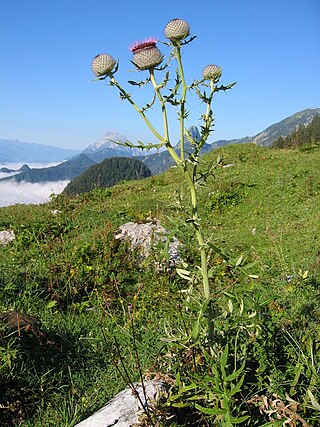
The potato is a starchy tuberous vegetable native to the Americas that is consumed as a staple food in many parts of the world. Potatoes are underground tubers of the plant Solanum tuberosum, a perennial in the nightshade family Solanaceae.

Cirsium is a genus of perennial and biennial flowering plants in the Asteraceae, one of several genera known commonly as thistles. They are more precisely known as plume thistles. These differ from other thistle genera in having a seed with a pappus of feathered hairs on their achenes. The other genera have a pappus of simple unbranched hairs.

Allium tuberosum is a species of plant native to the Chinese province of Shanxi, and cultivated and naturalized elsewhere in Asia and around the world. It has a number of uses in Asian cuisine.

Cirsium vulgare, the spear thistle, bull thistle, or common thistle, is a species of the Asteraceae genus Cirsium, native throughout most of Europe, Western Asia, and northwestern Africa. It is also naturalised in North America, Africa, and Australia and is an invasive weed in several regions. It is the national flower of Scotland.

Cirsium palustre, the marsh thistle or European swamp thistle, is a herbaceous biennial flowering plant in the family Asteraceae.

Cirsium arvense is a perennial species of flowering plant in the family Asteraceae, native throughout Europe and western Asia, northern Africa and widely introduced elsewhere. The standard English name in its native area is creeping thistle. It is also commonly known as Canada thistle and field thistle.

Thistle is the common name of a group of flowering plants characterized by leaves with sharp prickles on the margins, mostly in the family Asteraceae. Prickles can also occur all over the plant – on the stem and on the flat parts of the leaves. These prickles protect the plant from herbivores. Typically, an involucre with a clasping shape similar to a cup or urn subtends each of a thistle's flower heads. The typically feathery pappus of a ripe thistle flower is known as thistle-down.

Chlorophytum tuberosum is a species of flowering plant in the Asparagaceae family. It is one of several species known by the common name musli. It is native to parts of Africa and India. It has historical uses in Ayurveda.
NVC community CG2 is one of the calcicolous grassland communities in the British National Vegetation Classification system. It is one of three short-sward communities associated with heavy grazing, within the lowland calcicolous grassland group, and is regarded as "typical" chalk grassland.
British NVC community MG5 is one of the mesotrophic grassland communities in the British National Vegetation Classification system. It is one of four such communities associated with well-drained permanent pastures and meadows.

Cirsium eriophorum, the woolly thistle, is a herbaceous biennial species of flowering plant in the genus Cirsium of the family Asteraceae. It is widespread across much of Europe. It is a large biennial plant with sharp spines on the tips of the leaves, and long, woolly hairs on much of the foliage. The flower heads are large and nearly spherical, with spines on the outside and many purple disc florets but no ray florets.
Trigonosciadium is a genus in the family Apiaceae. Trigonosciadium brachytaenium is endemic to Iran, whereas T. tuberosum and T. viscidulum grow in Iran, Anatolia and Iraq.

Cirsium scariosum is a species of thistle known by the common names meadow thistle, elk thistle and dwarf thistle. It is native to much of western North America from Alberta and British Columbia, south to Baja California. There are also isolated populations on the Canadian Atlantic Coast, on the Mingan Archipelago in Québec, where it is called the Mingan thistle.
Lolium tuberosum is a species of flowering plant in the family Poaceae, native to Spain and Morocco. It was first described in 1983 as Micropyropsis tuberosa. When placed in the genus Micropyropsis, it was the only species. Under its synonym, the species is listed as endangered.

Zygaena lonicerae, the narrow-bordered five-spot burnet, is a moth of the family Zygaenidae. The species was first described by Theodor Gottlieb von Scheven in 1777.

Cirsium dissectum, also known as meadow thistle, is an erect perennial herb. It is found in Great Britain, Ireland, France, the Netherlands, Germany, Italy, Spain, Hungary, Norway, etc. It is found in fens and less acidic peat bogs i.e. it prefers damp boggy areas.

Jordanita globulariae, also known as the scarce forester, is a day-flying moth of the family Zygaenidae.

Lithospermum tuberosum, commonly called the southern stoneseed or tuberous stoneseed, is a species of flowering plant in the forget-me-not family. It is native to the Southeastern United States, where it is found in calcareous woodlands.

Cirsium brachycephalum is a species of flowering plant belonging to the family Asteraceae.

Geranium tuberosum, the tuberous-rooted cranesbill, is a species of flowering plant in the family Geraniaceae. It is native to the Mediterranean region, the Caucasus, and western Asia. The Royal Horticultural Society considers it a good plant to attract pollinators, and it is widely available from commercial suppliers. There are a number of cultivars available, including 'Rosie's Mauve' and 'Richard Hobbs'.
















